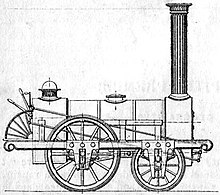Steam locomotive
A steam locomotive is a steam powered railway locomotive. It was used a lot between about 1830 and 1970. Afterwards, diesel and electric locomotives were used more often. The first steam locomotive was made by Richard Trevithick for a railway used for moving iron at an Ironworks in Wales. A steam locomotive works by burning a fuel like coal in a special space called a firebox. This produces hot gases that rise and go through tubes in a boiler - a large space with water in it. This heats the water, producing steam. The steam is then taken through another tube to a cylinder. The steam then pushes the piston which in turn pushes a metal rod that is connected to the wheels, making the locomotive move. The steam then rises out through the chimney.

Steam locomotives are still today used in many developing countries where the railways have not yet been electrified.
Other websites
change- GKB 671:The longest serving steam locomotive in the world (since 1860)
- Database of surviving steam locomotives in North America
- Information on North American steam railroads in operation
- UK heritage railways and preserved locomotives database
- Pages for the British project to build a modern steam locomotive. The Advanced Steam Locomotive. (5AT)
- International Steam Locomotives Archived 2010-02-18 at the Wayback Machine
- Tracks of Time Archived 2009-06-05 at the Wayback Machine